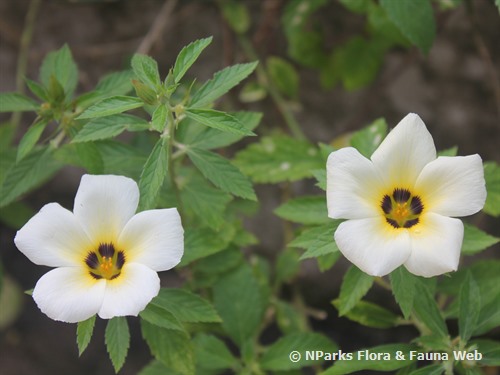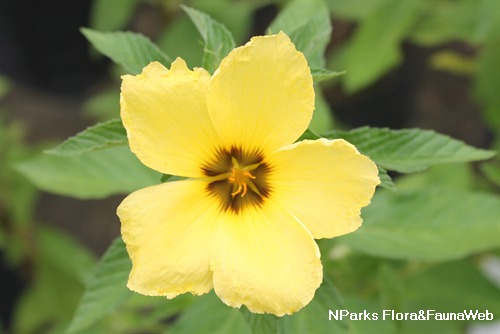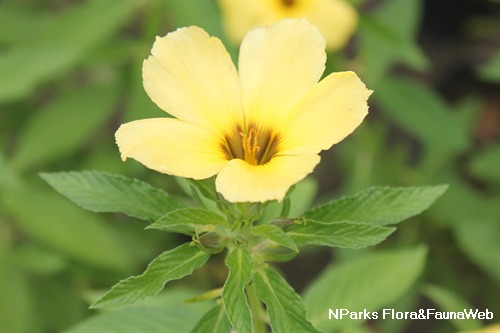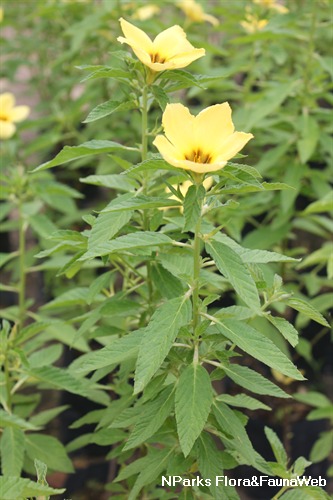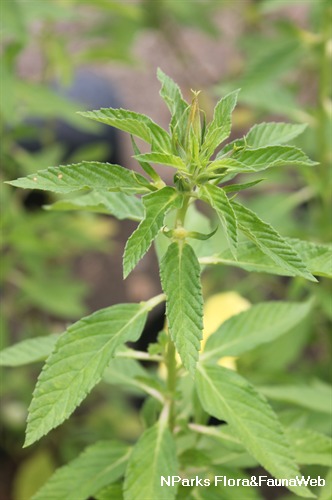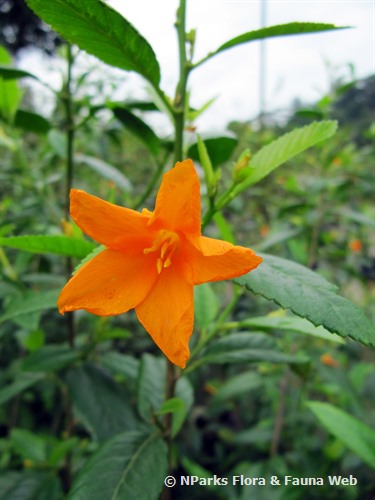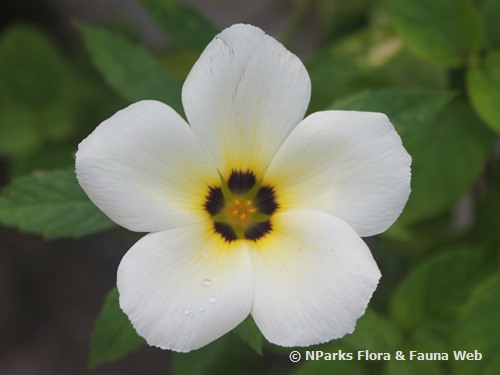
Back
Turnera subulata
| Family Name: | Turneraceae |
| Common Name: | White Alder, Sulphur Alder, Dark-eyed Turnera, White Buttercup, Politician's Flower |
Name
Classifications and Characteristics
| Plant Division | Angiosperms (Flowering Seed Plants) (Dicotyledon) |
|---|---|
| Plant Growth Form | Shrub |
| Maximum Height | 0.3 m to 0.8 m |
Biogeography
| Native Distribution | Tropical America |
|---|---|
| Native Habitat | Terrestrial (Disturbed Area / Open Ground) |
| Preferred Climate Zone | Tropical |
| Local Conservation Status | Non-native (Spontaneous (Naturalised)) |
Description and Ethnobotany
| Growth Form | Perennial herb with erect stems up to 0.8 m tall. |
|---|---|
| Foliage | Lanceolate leaves have a toothed leaf margin. There is a pair of round, greenish to yellowish glands at the base of the leaf blade on either side of the petiole. Venation is prominent with the leaf blade slightly bulging between veins. The leaf surface is covered in short, white hairs. |
| Flowers | Large, dark-eyed flowers are composed of 5 obovate petals which are cream-coloured and yellow at the base or solid yellow. There are 2 flower forms: 1) thrum flowers where the stamens (male, pollen-producing part) are taller than the styles (female, egg-bearing parts) and 2) pin flowers where the stamens are shorter than the styles. Flowers cannot self-pollinate, requiring pollen from another flower to produce seeds. |
| Similar | This species is similar to Turnera ulmifolia, but it has a dark eye, while T. ulmifolia does not. |
Landscaping Features
| Desirable Plant Features | Ornamental Flowers |
|---|
Fauna, Pollination and Dispersal
| Fauna Pollination Dispersal Associated Fauna | Butterfly-Attracting, Bee-Attracting |
|---|---|
| Pollination Method(s) | Biotic (Fauna) (Insects (Bee), Insects (Ant, Beetle, Fly, Thrip, Wasp)) |
Plant Care and Propagation
| Light Preference | Full Sun |
|---|---|
| Water Preference | Moderate Water |
| Propagation Method | Seed |
Foliar
| Mature Foliage Colour(s) | Green |
|---|---|
| Foliar Type | Simple / Unifoliate |
| Foliar Arrangement Along Stem | Spiral |
| Foliar Attachment to Stem | Petiolate |
| Foliar Shape(s) | Non-Palm Foliage (Lanceolate, Elliptical) |
| Foliar Venation | Pinnate / Net |
| Foliar Margin | Serrate / Toothed |
| Foliar Apex - Tip | Acuminate |
| Foliar Base | Rounded / Obtuse |
| Leaf Area Index (LAI) for Green Plot Ratio | 4.5 (Shrub & Groundcover - Dicot) |
Floral (Angiosperm)
| Flower & Plant Sexuality | Bisexual Flowers |
| Flower Colour(s) | Yellow / Golden, Black, Cream / Off-White |
|---|---|
| Flower Texture(s) | Smooth |
| Flower Grouping | Solitary |
| Flower Location | Terminal |
| Flower Symmetry | Radial |
| Individual Flower Shape | Funnelform / Funnel-shaped |
| Flowering Period | Free-Flowering |
| Flowering Opening Time | Daytime |
| Flowering Habit | Polycarpic |
| Flowering Opening Time Remarks | Flowers open in the morning at about 8AM and close by noon. |
| Flower Size | 5 cm |
References
| References | Swamy, N. R. & Bahadur B.. 1984. Pollen Flow in Dimorphic Turnera subulata. New Phytologist. 98. 1. 205-209 |
|---|
Image Repository
Others
| Master ID | 1241 |
|---|---|
| Species ID | 2534 |
| Flora Disclaimer | The information in this website has been compiled from reliable sources, such as reference works on medicinal plants. It is not a substitute for medical advice or treatment and NParks does not purport to provide any medical advice. Readers should always consult his/her physician before using or consuming a plant for medicinal purposes. |

